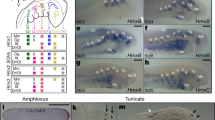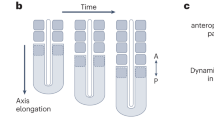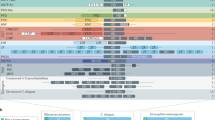Abstract
The process of segmentation, in which repeated homologous structures are generated along the anterior–posterior axis of the embryo is a widespread mechanism in animal development. In vertebrates, segmentation is most apparent in the somites and the peripheral nervous system1,2, but the existence of repetitive bulges, termed neuromeres, in the early neural epithelium of vertebrates suggests that the CNS may also be segmented3–9. Consistent with this, cranial ganglia8 and certain neurons8,10 are associated with specific hindbrain neuromeres. Here, we report that Krox-20 a zinc-finger gene, is expressed in two alternate neuromeres in the mouse early hindbrain. This pattern subsequently decays and Krox-20 is transiently expressed in specific hindbrain nuclei. In addition, Krox-20 is expressed in early neural crest cells, and then in the neural crest-derived boundary caps, glial components of the cranial and spinal ganglia. The demonstration that neuromeres are domains of gene expression provides molecular evidence for the segmentation of the CNS.
This is a preview of subscription content, access via your institution
Access options
Subscribe to this journal
Receive 51 print issues and online access
$199.00 per year
only $3.90 per issue
Buy this article
- Purchase on Springer Link
- Instant access to full article PDF
Prices may be subject to local taxes which are calculated during checkout
Similar content being viewed by others
References
Hogan, B., Holland, P. & Schofield, P. Trends Genet. 1, 67–74 (1985).
Keynes, R. J. & Stern, C. D. Development 103, 413–429 (1988).
Orr, H. J. Morph. 1, 311–372 (1887).
Streeter, G. L. Anat. Rec. 2, 111–115 (1908).
Neal, H. V. J. Morph. 31, 293–315 (1918).
Adelmann, H. B. J. comp. Neurol. 39, 19–171 (1925).
Bergquist, H. & Kallen, B. B. J. comp. Neurol. 100, 627–660 (1954).
Vaage, S. Adv. Anat. Embryol. Cell. Biol. 41, 1–88 (1969).
Tuckett, F., Lim, L. & Morriss-Kay, G. M. J. Embryol. exp. Morph. 87, 215–228 (1985).
Hanneman, E., Trevarrow, B., Metcalf, W. K., Kimmel, C. B. & Westerfield, M. Development 103, 49–58 (1988).
Chavrier, P. et al. EMBO J. 7, 29–35 (1988).
Almendral, J. M. et al. Molec. cell. Biol. 8, 2140–2148 (1988).
D'Amico-Martel, A. & Noden, D. M. Am. J. Anat. 166, 445–468 (1983).
Altman, J. & Bayer, S. Adv. Anat. Embryol. Cell Biol. 74, 1–90 (1982).
Le Douarin, N. M. The Neural Crest (Cambridge University Press, 1982).
Noden, D. M. Devl Biol. 96, 144–165 (1983).
Thorogood, P. in Mesenchymal-Epithelial Interactions in Neural Development 141–152 (Springer, New York, 1987).
Lumsden, A. G. S. & Keynes, R. J. Nature 337, 424–428 (1989).
Akam, M. Development 101, 1–22 (1987).
Ingham, P. W. Nature 335, 25–34 (1988).
Doe, C. Q. & Scott, M. P. Trends Neurosci. 11, 101–106 (1988).
Holland, P. W. H. & Hogan, B. L. M. Genes Dev. 2, 773–782 (1988).
Gaunt, S. J., Sharpe, P. T. & Duboule, D. Development (in the press).
Gaunt, S. J. Development 101, 51–60 (1987).
Chowdhury, K., Deutsch, U. & Gruss, P. Cell 48, 771–778 (1987).
Chavrier, P., Lemaire, P., Revelant, O., Bravo, R. & Charnay, P. Molec. cell. Biol. 8, 1319–1326 (1988).
Chowdhury, K., Dressler, G., Breier, G., Deutsch, U. & Gruss, P. EMBO J. 7, 1345–1353 (1988).
Milbrandt, J. Science 238, 797–799 (1987).
Lemaire, P., Revelant, O., Bravo, R. & Charnay, P. Proc. natn. Acad. Sci. U.S.A. 85, 4691–4695 (1988).
Sukhatme, V. P. et al. Cell. 53, 37–43 (1988).
Theiler, K. The House Mouse (Springer, Berlin, 1972).
Wilkinson, D. G., Bailes, J. A. & McMahon, A. P. Cell 50, 79–88 (1987).
Author information
Authors and Affiliations
Rights and permissions
About this article
Cite this article
Wilkinson, D., Bhatt, S., Chavrier, P. et al. Segment-specific expression of a zinc-finger gene in the developing nervous system of the mouse. Nature 337, 461–464 (1989). https://doi.org/10.1038/337461a0
Received:
Accepted:
Issue Date:
DOI: https://doi.org/10.1038/337461a0
This article is cited by
-
Combined whole-mount fluorescence in situ hybridization and antibody staining in zebrafish embryos and larvae
Nature Protocols (2020)
-
The effects of five types of tea solutions on epiboly process, neural and cardiovascular development, and locomotor capacity of zebrafish
Cell Biology and Toxicology (2019)
-
Neural crest stem cells protect spinal cord neurons from excitotoxic damage and inhibit glial activation by secretion of brain-derived neurotrophic factor
Cell and Tissue Research (2018)
-
A novel function for Egr4 in posterior hindbrain development
Scientific Reports (2015)
-
The gene regulatory networks underlying formation of the auditory hindbrain
Cellular and Molecular Life Sciences (2015)
Comments
By submitting a comment you agree to abide by our Terms and Community Guidelines. If you find something abusive or that does not comply with our terms or guidelines please flag it as inappropriate.



